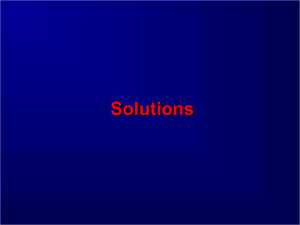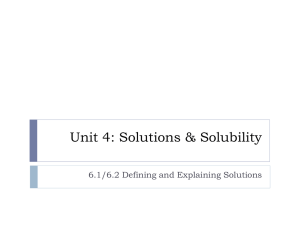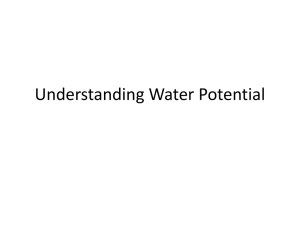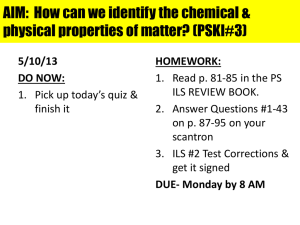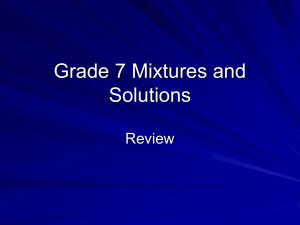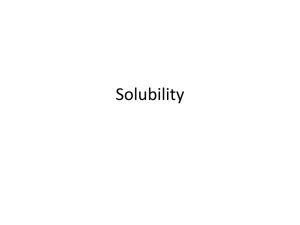Chapter 7 Notes
advertisement
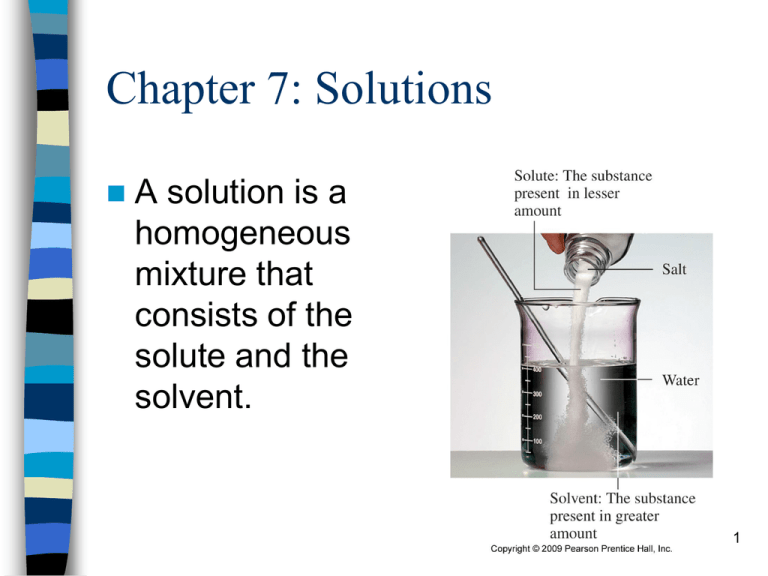
Chapter 7: Solutions A solution is a homogeneous mixture that consists of the solute and the solvent. 1 Liquid Solutions The solute can NOT be separated from the solvent by filtration. It can ONLY be separated by evaporation of the solvent. Solute particles are not visible, but can produce a colored solution. 2 Types of Solutions 3 Water as a Solvent Water is one of the most common (and important!) solvents as it can dissolve a variety of substances. Water is highly polar (Ch. 4) with hydrogen bonding intermolecular forces. 4 Water as a Solvent Water dissolves most ionic compounds. When NaCl dissolves in water, sodium ions at the surface are attracted to the oxygen atoms in water and the chloride ions at the surface are attracted to the hydrogen atoms in water. Each ion is surrounded by six water molecules referred to as a hydration sphere. 5 Water as a Solvent Video 6 Water as a Solvent Water also dissolves highly polar molecules like formaldehyde (CH2O) and molecules with hydrogen bonding like methanol. 7 CCl4 – a Non-polar solvent Carbon tetrachloride is a tetrahedral molecule, but each C-Cl bond pulls in an equal and opposite direction making it non-polar. 8 CCl4 – a Non-polar solvent Only non-polar solutes will dissolve in CCl4. Ex) I2, C10H8, and CS2. What do these have in common? 9 Summary of Solubility “Like dissolves like” Water Ni(NO3)2 dissolves in polar layer Distinct boundary layer CCl4 I2 dissolves in non-polar layer 10 Learning Check Would the following substances be soluble in Water or CCl4? – Glyceraldehyde (a simple sugar) – Hexane – CaCl2 – Br2 11 Electrolytes Pure water is a poor conductor of electricity. When ions are present, though, water becomes an excellent conductor. 12 Strong, Weak, and Non-electrolytes Strong electrolytes are substances that completely dissociate into ions when in water. Most ionic compounds are strong electrolytes. 13 Strong, Weak, and Non-electrolytes Weak electrolytes are substances that partially dissociate into ions when in water. Weak acids and weak bases are weak electrolytes. 14 Strong, Weak, and Non-electrolytes Non-electrolytes are substances that dissolve in water, but produce no ions. These are molecular compounds like the alcohols and sugars. 15 Formation of Ions Split the following into ions. – NaCl – CaCl2 – Na2SO4 – Al(NO3)3 16 Equivalent (Eq) An equivalent is the amount of an electrolyte that produces one mole of charge. Does NOT depend on the type of charge (positive or negative), just the magnitude of the charge. 1 mole Na+ = 1 Eq 1 mole Ca+2 = 2 Eq 1 mole PO4-3 = 3 Eq 17 Equivalent Determine the number of equivalents present in: – 0.25 moles of Mg+2 – 0.23g of Na+1 – 4.50g of CO3-2 Convert Eq to grams – A solution contains 0.23 Equivalents of HPO4-2. What mass is present? 18 Electrolytes in Body Fluids In replacement solutions for body fluids, the electrolytes are given in milliequivalents per liter (mEq/L). Ringer’s Solution (Saline) Na+ 147 mEq/L Cl− K+ 4 mEq/L Ca2+ 4 mEq/L 155 mEq/L Note that the mEq/L of cations must equal the mEq/L of anions. 19 Solubility Solubility is the maximum amount of solvent that can be dissolved in a specific amount of solvent. Usually expressed as the mass of solute per 100. grams of solvent. 20 Unsaturated Solution When a solution could dissolve more of the solute, it is said to be unsaturated. 21 Saturated Solution Contains the maximum amount of solute allowed. If you added more solid, it will not dissolve. 22 Solubility and Temperature Most solid solutes will increase in solubility with an increase in the temperature. Can produce a super-saturated solution! 23 Sodium Acetate Start with 160g of NaC2H3O2 in 100mL of water at 20oC. Begin to warm to 100oC. Then cool – no solid forms! Temperature 20o C 60o C 100o C Solubility Limit 46g / 100mL 139g / 100mL 170g / 100mL 24 Sodium Acetate 25 Solubility and Temperature The solubility of a gas in a liquid decreases with an increase in temperature. Fish need >5ppm to thrive. 26 Concentration of Solutions The quantity of solute in a solution can be defined as a percentage. Used commonly in the health field. Mass / Mass Percentage (m/m or w/w). = mass of solute (g) x 100 mass of solution (g) 27 Concentration of Solution Volume / Volume Percentage (v/v). = volume of solute (mL) x 100 volume of solution (mL) Mass / Volume Percentage (m/v or w/v). = mass of solute (g) x 100 volume of solution (mL) 28 Using a Percentage A percentage can be written as a fraction and then used as a conversion factor. Thus, a 5.0% NaCl (m/m) can be written as: 5.0 g of NaCl 100.g of solution 29 Molarity Chemists use this method for concentration. M = moles of solute / Liters of solution. Problems may involve mass that must be converted to moles. 30 Dilution Stock solutions are often diluted to use in a laboratory. The moles of solute remain the same! C1 x V1 = C2 x V2 C’s can be either a percentage or a molarity. V’s can be either milliliters or liters, but both must be the same unit. 31 Solution Stoichiometry Molarity and volumes can be used to calculate quantities for an aqueous reaction. Remember that M = Moles / Liters. Will require a mole-to-mole conversion in second step from balanced reaction. 32 Solutions A solution: – is transparent (may be colored). – contains tiny solute particles, which are not visible. – does not settle out over time. – can not be filtered. 33 Colloids A colloid contains larger solute particles that causes the “Tyndall effect.” A collloid: – will be opaque. – can not be filtered. – does not settle out over time. – can be separated by a semi-permeable membrane. 34 Types of Colloids Aerosol = a liquid or solid in a gas. Foam = a gas in a liquid or solid. Emulsion = a liquid or solid in a liquid. Sol = a liquid or solid in a solid. 35 Suspensions A suspension contains very large solute particles. A suspension: – is opaque. – will settle out over time. – can be filtered. 36 Comparison 37 Learning Check Classify as a solution, colloid, or suspension. – The CaCO3 made a few weeks ago in the lab (Chemical Reaction exercise). – Mixing a Crystal lightTR packet with water. – Orange juice (no pulp). 38 Osmosis When a semi-permeable membrane separates two solutions, only the solvent molecules can move across the barrier. If two solutions of different concentrations are placed on either side of the barrier, then the solvent will flow from the lower solute side to the higher solute side. To prevent this, an external pressure would be needed to stop the net flow. 39 Osmosis 40 Osmotic Pressure The pressure necessary to prevent the net flow is proportional to the molarity of the solution. Higher molarity = Higher osmotic pressure. 41 Learning Check A semipermeable membrane separates a 10% sucrose solution A from a 5% sucrose solution B. If sucrose is a colloid, fill in the blanks in the statements below. 1. Solution ____ has the greater osmotic pressure. 2. Water initially flows from ___ into ___. 3. The level of solution ____will be lower. 42 Importance of Osmosis Our cells have semi-permeable membranes to contain the cell materials inside. Our blood plasma has an osmotic pressure equal to that of our red blood cells. Any external fluid administered like an I.V. must be isotonic. 43 Isotonic Solutions A saline solution (NaCl) will have a concentration of 0.90% (m/v). A glucose (aka dextrose) will have a concentration of 5.0% (m/v). 44 Hypotonic Solutions If a solution of lower concentration comes into contact with a red blood cell, that solution is said to be hypotonic. 45 Hypertonic Solutions If a solution of higher concentration comes into contact with a red blood cell, that solution is said to be hypertonic. 46 Learning Check When placed in each of the following, indicate if a red blood cell will 1) not change, 2) hemolyze, or 3) crenate. A.____ 5% glucose solution B.____ 1% glucose solution C.____ 0.5% NaCl solution D.____ 2% NaCl solution 47
